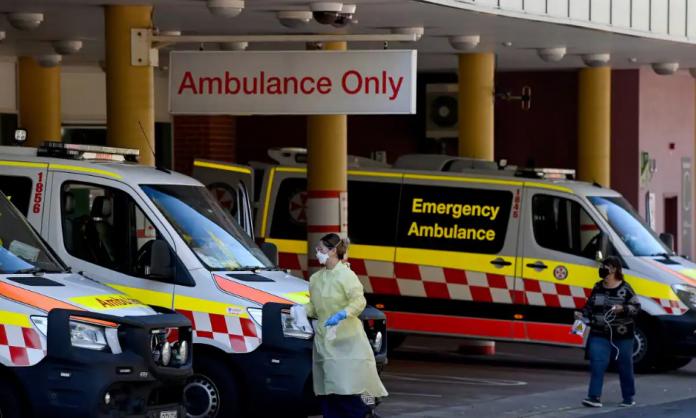Is the pandemic over in Australia? You would think so if you went by the recent election campaign, in which COVID rated barely a mention. Yet the Australian Electoral Commission had to introduce phone voting due to the number of people unable to vote any other way because they were in isolation.
Australia currently has one of the highest COVID case rates and death rates in the world. You wouldn’t know this from any mainstream news source.
There are currently more than 40 deaths per day due to COVID in Australia—worthy of less comment than the weather forecast. The normalisation of the human suffering and grief buried in that number has been one of the successes for the ruling class out of the pandemic everywhere.
More than 70 percent of the 8,900 reported deaths from COVID in Australia to date have occurred in 2022—and we’re not even halfway through the year.
Australia is on track to reach approximately 15,000 to 18,000 deaths from COVID in 2022—up to sixteen times the annual road toll (which was 1,127 in 2021) and six times the deaths from the worst recent flu season (3,024 in 2017), according to OzSage, an independent multidisciplinary network of Australian scientific experts.
More than 7,380,000 infections have been recorded across Australia. Testing is going down as PCRs become harder to access and RATs at $10 each are too expensive for many to use routinely, so case numbers are most likely understated.
Little is known about the prevalence of long COVID across the country. Health economist Professor Martin Hensher summed up the situation: “At the moment we really have no idea of the extent of long COVID in Australia. We are flying pretty blind”.
In Britain, where the government allowed the virus to get out of control much earlier, 2 million people have suffered from long COVID. Of them, 376,000 have not recovered after two years.
These awful facts explain why, in February 2022, OzSage produced an open letter to Australian federal and state governments, prompted by opposition to “governments ending the policies that have protected the community during the pandemic to date”.
Among their predicted outcomes if health measures were not maintained were: increased circulation and transmission of COVID, including reinfection; new variants which are just as likely to be fast-spreading, more severe or vaccine-resistant; preventable COVID-related illness, disability, hospitalisations and death; limited ability to access other necessary medical care due to a health system overloaded with acute and chronic effects from COVID; and an increase in chronic health problems.
All the outcomes they predicted have come to pass.
Instead of heeding expert advice, governments have moved in the opposite direction. In April, most of the health measures that had been effective in slowing transmission were junked, such as requiring those who are household contacts of a positive case to isolate for seven days.
NSW Premier Dominic Perrottet said when he announced this on 20 April: “Today is a day where the people of our state in NSW can be incredibly proud. We have had an incredibly low death rate, we have put downward pressure on our health system and that is because of the efforts and sacrifice people have made. Overall, the balance we have been able to strike here in our state has led not just the country, but the world”.
But the gains of the first eighteen months of the pandemic are rapidly being thrown away. Australia is quickly catching up with those grim international statistics.
The risk of contracting COVID is now individualised. Far better if we blame the people not wearing masks on the train rather than the constant messaging from governments and bosses that health measures are now pretty much unnecessary.
It has not been just the Coalition government in NSW that let the virus rip. State Labor governments have played the same role in the drive to reopen. Since the Western Australian Labor government reopened the border on 3 March, the state has recorded more than 750,000 infections. All but eleven of the 279 COVID deaths in WA since the start of the pandemic have occurred since that reopening.
OzSage issued an “Urgent call for action” on 23 May:
“Hospitalisations remain high, with over 3,000 people admitted nationwide. This has resulted in overcrowded emergency departments and contributed to ambulance ramping and unacceptable ambulance response times, adversely affecting the provision of care for other health conditions. Higher COVID case numbers are leading to increased hospitalisation, suffering and death.
“This is the first time an infectious disease has been a leading cause of death in modern history.”
So why would governments disregard this? The short answer is profits.
Perrottet’s comment followed a demand from Qantas CEO Alan Joyce for aviation workers to be exempted from isolation rules. Joyce said up to 18 percent of the airline’s workforce was unable to work due to infection or exposure.
The ABC reported in April that the government had also come under pressure from other businesses to remove the close contact isolation requirement. Since no boss can turn a profit without their workers on site, they must be allowed to come to work regardless of the health consequences.
While OzSage might struggle to get their voice heard, the media continue to foreground the opinions of those well-known scientific experts: small business owners. In April, the ABC published the expert opinion of a Parramatta restaurant owner: “I think we are on the tail end of the pandemic”.
As we enter the winter months and more indoor activities with health measures all but discarded, nothing could be further from the truth.









